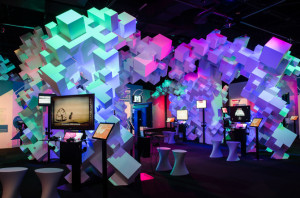Arts Spotlight: Arts, Design & Technology
Art and technology are a core part of this region’s progress and identity. We are recognized as a hub of technological innovation as well as for our dynamic and creative cultural community, and tech companies, gamers, designers and artists alike and together, are pushing boundaries and shaping the future.
At ArtsFund’s 2016 Celebration of the Arts Luncheon, keynote address by John Maeda will focus on the role of arts and design in the digital age. Building off the themes of the luncheon keynote, we spotlight three ArtsFund grantees working in the intersections of arts and technology. Whether showcasing the artistry of video games, challenging historical norms and expectations around privacy, or employing cutting edge technology in live performance, these projects at the EMP Museum, Henry Art Gallery, and the Seattle Symphony are prime examples of the synergy between arts, design and technology.
EMP Museum, Indie Game Revolution
The Puget Sound is home to over 300 video game companies and countless individual game makers, and is a hub for technological innovation. The EMP Museum is showcasing how a new breed of gamers are leaving their mark on gaming history at EMP’s Indie Game Revolution, a two year resident exhibit which premiered in November, 2014. Indie Game Revolution invites us to experience how the independent video game community is pushing past conventional boundaries with explosive new-age technology, capturing the attention and imagination of indie and mainstream audiences alike. Featuring the stories of more than forty independent video game developers, designers, coders, and composers, the exhibit presents a dynamic, immersive space inviting us to witness the present and future of gaming as it unfolds.

Photo by Jacob McMurray
The gallery soundtrack is made up of tracks from 22 different composers working in indie games, highlighting the integral role of music in gaming. “Sound is one of the most important tools we have as game designers. It can like give us information that can’t necessarily be communicated with art and graphics and motion.” – Ben Esposito, developer of Donut County.
Exhibition open now, click here for tickets and more information.
Henry Art Gallery, Sanctum
Sanctum was an interactive public art installation challenging historical norms and expectations around privacy in an increasingly digital and open source world.The installation, by James Coupe and Juan Pampin and commissioned by the Henry Art Gallery, activated the Henry’s front entracnce façade from 2013-2015.
Sanctum employed surveillance systems to generate cinematic narratives with social media content that matched the demographic profile of passers-by. The narratives were presented day and night on 18 LCD monitors using text, images, and audio. The cycle began when surveillance cameras captured the face of a passing pedestrian. Facial recognition software identified the individual’s gender and approximate age; the monitor then displayed images and Facebook status updates from people in the same demographic, airing an audio version of those updates through ultrasonic speakers. Sanctum explored the narrative potential of social media while raising questions about the conflicting imperatives emerging in our culture as we promote and embrace ever-more-intrusive electronic media, while still cherishing traditional notions of privacy in a public sphere. During its eighteen month run, Sanctum was viewed by over 138,000 museum visitors in addition to the thousands of UW students, faculty, and staff who walked past the Henry each day.
Sanctum was made in collaboration with the Center for Digital Arts and Experimental Media (DXARTS), University of Washington, and ran from May 04, 2013 — August 23, 2015. Click here for more information.
Seattle Symphony Conducts with Kinect
Reaching for the sky or making a fist are not typical conducting gestures, but then robotic instruments aren’t typical either for Music Director Ludovic Morlot. Gestural interaction designer Dimitri Diakopoulos used a Microsoft Kinect to make it possible for Morlot to conduct not only live musicians, but a set of reed horns, chimes and a grand piano equipped with robotic devices during the world premiere of Above, Below and In Between, written by Seattle-based sculptor, sound artist and composer, Trimpin. The piece, which also included a soprano and nine members of the Seattle Symphony, was part of the Symphony’s late-night [untitled] series, which explores new creative directions in music. Trimpin’s site-specific composition performed by robotic instruments and live musicians brought together by gestural interaction technology created an unforgettable experience for the listener. In January, the live recording was released on the Seattle Symphony Media label.
Click here to watch a video with more on how music and technology connect.
ArtsFund is proud to support these organizations, and many more throughout our region, designing new experiences and advancing our awareness of contemporary culture and our evolving societal norms.
Click here for a complete list of ArtsFund grantees.
Photos: Henry Art Gallery, Sanctum, Photo by R.J. Sánchez; EMP Museum, Indie Game Revolution, Photo by Jacob McMurray.
